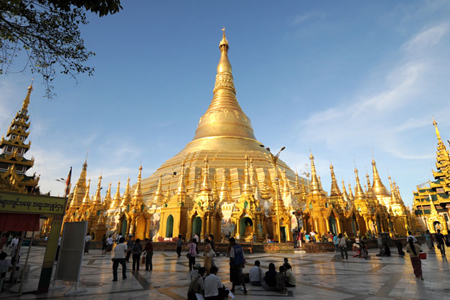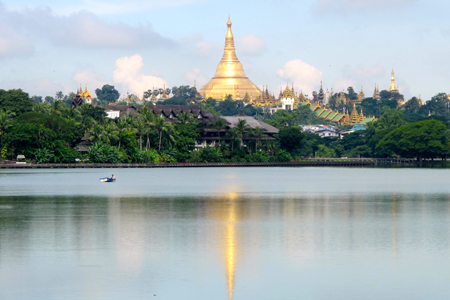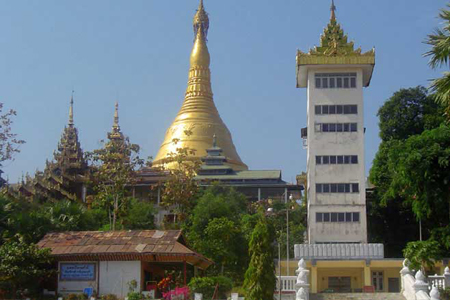Yangon - Myanmar today retains its charm and beauty with wide streets, the lush green trees along the road and the tranquil lakes. Another attraction for those who travel to Myanmar is its unique architecture. Shwedagon pagoda is considered as one of the ancient wonders of the world. The pagoda has 98 meters high, and it is the yellow light in the bustling city. Therefore you can see the temple in any place in the city. Trees are also an important part of adorning around the city.

For a long time, Shwedagon Pagoda is always the best things for tourists to discover. According to legend, the pagoda was built for 2500 years ago and stored the hair of the Buddha. In centuries, the local people have donated their property as part of the merit accumulated to build the temple. They have donated gold and jewels to the pagoda. Until now there have more than 80 000 jewelry in the pagoda, especially diamond stud sphere is placed on top of the pagoda. The surrounded areas are many other temples and some the small shop, which serves pilgrims visit this place. This is also the main place where the whole country pays homage to the Buddha. When traveling in Yangon, you can witness the rituals of Myanmar Buddhist center when they pray and offer to the Buddha.
Yangon - Myanmar is previously a small town called Dagon on the outskirts of the ancient kingdom of Okkalapa. In 1755, the 3rd reign of Myanmar, Alaungpaya King - ruler of northern Myanmar, brought down the conquered tribes in the south and the area is named Yangon, meaning End of Strife (or "the last stand"). But then, the city had been invaded by British colonists and it had become a bustling port. After the British left, they left the city a beautiful and unique architecture, the structures were fully highlighted a unique Myanmar.
Yangon is a fascinating attraction that any visitor should not miss. Besides the famous temple such as Botahtaung, Sule, and Chaukhtatgyi, there are some other unique architectures such as Hindu temples, Mosques, and Churches. National Museum of Myanmar still kept a lot of treasures from the ancient kingdoms. You can also walk in the park next to the Kandawgyi Lake or wandering in the markets of the city.

Bogyoke Aung San Market (Scott Market) is a big commercial center that most tourists cannot be missed when visiting Yangon, located in the city center, where trade everything from gems to luxury silk products.
For those who need refreshment and cuisine, Yangon has a lot of refreshment with full-service options for visitors including Japanese, Korean, Chinese, Thai and Asian cuisine, and of course Burmese cuisine.
Wandering around Yangon, you will feel that you are lost in another world, the world of the "sleepy" villages. The town of Thanlyin and Kyauktan is typical with the old monasteries and the temples sit hidden in the forest. The festivals in the Kyaik Khauk pagoda in Kyauktan town are one of the largest fairs in the region. The Twante village nearby is famous for its traditional pottery techniques stored until today.

In the north of Yangon City, along with the road head to the city of Mandalay, is Htaukkyant war cemetery, the landscape is so nice and quiet and the cemetery is managed by the Commonwealth War Graves Commission. The cemetery is still kept more than 6000 graves including the Allied soldiers and those who died in World War II. The center is a big marble monument carving the name of unknown 27,000 soldiers. The city of Bago sits next to Yangon which previously was called Hanthawaddy when it was still the capital of the Mon Kingdom, is a beautiful place which can be visited in day trips from Yangon. The main temple of Bago City is Shwemawdaw Temple and the festivals in the areas are the biggest festivals in the region near the end of Myanmar. The biggest Buddha statue in the area was only discovered when forests were cleared for construction of railroads in the 19th century. The size of the statue is larger than the statue Myathalyaung which recently completed in the south of Myanmar. Until now, it is still the 3rd largest Buddha statue in Myanmar.
